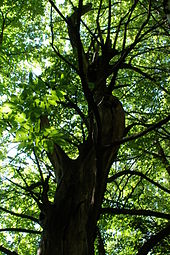Trees are an important component of the natural landscape because of their prevention of erosion and the provision of a weather-sheltered ecosystem in and under their foliage. They also play an important role in producing oxygen and reducing carbon dioxide in the atmosphere, as well as moderating ground temperatures. They are also elements in landscaping and agriculture, both for their aesthetic appeal and their orchard crops (such as apples). Wood from trees is a building material, as well as a primary energy source in many developing countries. Trees also play a role in many of the world's mythologies (see trees in mythology).

Tallest trees
A tree is a plant form that occurs in many different orders and families of plants. Most species of trees today are flowering plants (Angiosperms) and conifers. Trees show a variety of growth forms, leaf type and shape, bark characteristics and reproductive organs. For the listing of examples of well-known trees and how they are classified, see List of tree genera.

Some Benefits of Nut Trees in
The tree form has evolved separately in unrelated classes of plants, in response to similar environmental challenges, making it a classic example of parallel evolution. With an estimate of 100,000 tree species, the number of tree species worldwide might total 25 percent of all living plant species. The majority of tree species grow in tropical regions of the world and many of these areas have not been surveyed yet by botanists, making species diversity and ranges poorly understood. The earliest tree-like organisms were tree ferns, horsetails and lycophytes, which grew in forests in the Carboniferous period, however these were plants were not trees, since they lacked woody tissue. Trees evolved in the Triassic period, with conifers, ginkgos, cycads and other gymnosperms appeared producing woody tissue, and were subsequently followed by tree-form flowering plants in the Cretaceous period.

The roots of this tree

Interval Tree Java

Tree Clipart

Tree Posters

Tallest trees
A tree is a plant form that occurs in many different orders and families of plants. Most species of trees today are flowering plants (Angiosperms) and conifers. Trees show a variety of growth forms, leaf type and shape, bark characteristics and reproductive organs. For the listing of examples of well-known trees and how they are classified, see List of tree genera.

Some Benefits of Nut Trees in
The tree form has evolved separately in unrelated classes of plants, in response to similar environmental challenges, making it a classic example of parallel evolution. With an estimate of 100,000 tree species, the number of tree species worldwide might total 25 percent of all living plant species. The majority of tree species grow in tropical regions of the world and many of these areas have not been surveyed yet by botanists, making species diversity and ranges poorly understood. The earliest tree-like organisms were tree ferns, horsetails and lycophytes, which grew in forests in the Carboniferous period, however these were plants were not trees, since they lacked woody tissue. Trees evolved in the Triassic period, with conifers, ginkgos, cycads and other gymnosperms appeared producing woody tissue, and were subsequently followed by tree-form flowering plants in the Cretaceous period.

The roots of this tree

Interval Tree Java

Tree Clipart

Tree Posters
No comments:
Post a Comment